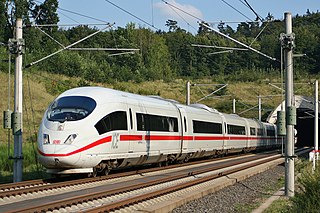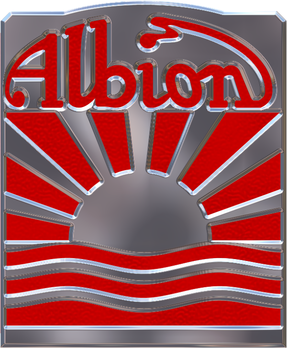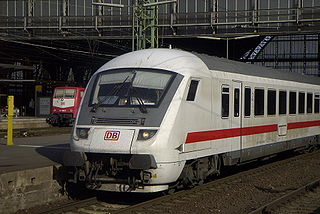
A diesel multiple unit or DMU is a multiple-unit train powered by on-board diesel engines. A DMU requires no separate locomotive, as the engines are incorporated into one or more of the carriages. Diesel-powered single-unit railcars are also generally classed as DMUs. Diesel-powered units may be further classified by their transmission type: diesel–mechanical DMMU, diesel–hydraulic DHMU, or diesel–electric DEMU.

A locomotive or engine is a rail transport vehicle that provides the motive power for a train. If a locomotive is capable of carrying a payload, it is usually rather referred to as a multiple unit, motor coach, railcar or power car; the use of these self-propelled vehicles is increasingly common for passenger trains, but rare for freight.

A multiple-unit train or simply multiple unit (MU) is a self-propelled train composed of one or more carriages joined, which when coupled to another multiple unit can be controlled by a single driver, with multiple-unit train control.

A bilevel car or double-decker coach is a type of rail car that has two levels of passenger accommodation as opposed to one, increasing passenger capacity.

A railbus is a lightweight passenger railcar that shares many aspects of its construction with a bus, typically having a bus body and four wheels on a fixed base, instead of on bogies. Originally designed and developed during the 1930s, railbuses have evolved into larger dimensions, with characteristics similar in appearance to a light railcar, with the terms railcar and railbus often used interchangeably. Railbuses designed for use specifically on little-used railway lines were commonly employed in countries such as Germany, Italy, France, the United Kingdom and Sweden.

The Union Pacific Railroad's M-10001 was a diesel-electric streamlined train built in 1934 by Pullman-Standard with a power system developed by General Motors Electro-Motive Corporation using a Winton 201A Diesel engine and General Electric generator, control equipment and traction motors. It was the UP's second streamliner after the M-10000, their first equipped with a diesel engine and was a longer train than its three-car predecessor. All cars were articulated—trucks were shared between each car. It was delivered on October 2, 1934, and was used for display, test and record-setting runs for the next two months before being returned to Pullman-Standard for an increase in power and capacity, following which it was placed into service as the City of Portland train. It has been nicknamed "The Banana".

The Budd Rail Diesel Car (RDC), also known as the Budd car or Buddliner, is a self-propelled diesel multiple unit (DMU) railcar. Between 1949 and 1962, 398 RDCs were built by the Budd Company of Philadelphia, Pennsylvania, United States. The cars were primarily adopted for passenger service in rural areas with low traffic density or in short-haul commuter service, and were less expensive to operate in this context than a traditional diesel locomotive-drawn train with coaches. The cars could be used singly or coupled together in train sets and controlled from the cab of the front unit. The RDC was one of the few DMU trains to achieve commercial success in North America. RDC trains were an early example of self-contained diesel multiple unit trains, an arrangement now in common use by railways all over the world.

Albion Motors was a Scottish automobile and commercial vehicle manufacturer.

The British Rail Class 201 six-car diesel-electric multiple units (DEMUs) were built in 1957–1958 at Eastleigh and underframes were built at Ashford.
Push–pull is a configuration for locomotive-hauled trains, allowing them to be driven from either end of the train, whether having a locomotive at each end or not.

The DSB Class MF is a Danish-built high-comfort medium/long distance diesel multiple-unit train. The sets were built by ABB Scandia in Randers. This train model has been operating in Denmark, Sweden and Israel since 1990. The name IC3 indicates simply that it is a three-carriage InterCity trainset.

A control car, cab car, control trailer, or driving trailer is a non-powered rail vehicle from which a train can be operated. As dedicated vehicles or regular passenger cars, they have one or two driver compartments with all the controls and gauges required to remotely operate the locomotive, including exterior locomotive equipment such as horns, bells, ploughs, and lights. They also have communications and safety systems such as GSM-R or European Train Control System (ETCS). Control cars enable push-pull operation when located on the end of a train opposite its locomotive by allowing the train to reverse direction at a terminus without moving the locomotive or turning the train around.

NSB Class 86 is a class of diesel-hydraulic multiple units built by Strømmens Værksted for the Norwegian State Railways (NSB). Thirty-eight motor cars and thirty-one trailers were built between 1937 and 1954, split between six subtypes designated a through f. Class 91 was a further delivery of ten units that had a more comfortable interior and designed for regional trains. The trains had good acceleration and a maximum speed of 100 kilometres per hour (62 mph), which made them suitable for most unelectrified lines in Norway. As most of the network gradually became electrified, the class became increasingly used on branch lines.

The X40 is a series of electric multiple units operated by SJ of Sweden. They are in service from Stockholm to Linköping, Västerås/Örebro, Uppsala and Gävle/Sandviken, and since 2010 to Gothenburg via Västerås. The double decker trains were built by Alstom from 2004–2008, with 43 units being delivered, either in a two-car or three-car configuration. It is based on the Coradia series, very similar to the French SNCF Class Z 26500 double decker trains, and similar to the X60-series.

The Uerdingen railbus is the common term for the multiple units which were developed by the German firm of Waggonfabrik Uerdingen for the Deutsche Bundesbahn and private railways after the Second World War. These vehicles were diesel-powered, twin-axle railbuses of light construction. The diesel motors were built into the chassis underneath the vehicle. The VT 95 and VT 98 of the former Deutsche Bundesbahn in particular, are associated with this concept. These vehicles were employed in passenger train duties on branch lines where steam or diesel train operations were less profitable. Including the units built under licence, a total of 1,492 power cars were built from 1950 to 1971; and the total number of units, including trailer and driving cars, was 3,306.

Metropolitan Railway electric multiple units were used on London's Metropolitan Railway after the lines were electrified in the early 20th century.

The 400/500 class rail motors are diesel trains built by New South Wales Government Railways primarily for use on regional lines throughout NSW. The trains have since been phased out following a rationalisation of country branch line rail services in November 1983. The 400 Class power cars were built in 1938 at the Eveleigh Carriage Workshops, while the 500 Class trailer cars were built by Ritchie Brothers at Auburn.

Diesel multiple units and railcars are trains, usually with passenger accommodation, that do not require a locomotive. Railcars can be single cars, while in multiple units cars are marshalled together with a driving position either end. As of December 2010, 23 percent of the rail passenger cars used on Network Rail are part of a diesel multiple unit.

Class 201, Class 202 and Class 203 were the TOPS codes for a series of Diesel-electric multiple units built for the Southern Region of British Railways in 1957–86. They were classified by the Southern Region as 6S, 6L and 6B respectively, and known collectively as the Hastings Diesels or Hastings Units. They were built for service on the Hastings Line, which had a restricted loading gauge due to deficiencies in the construction of the tunnels when the line was built between 1845 and 1852. The Hastings Units served from 1957 to 1988, being withdrawn when the Hastings Line was electrified with single-track sections through some of the tunnels.

















